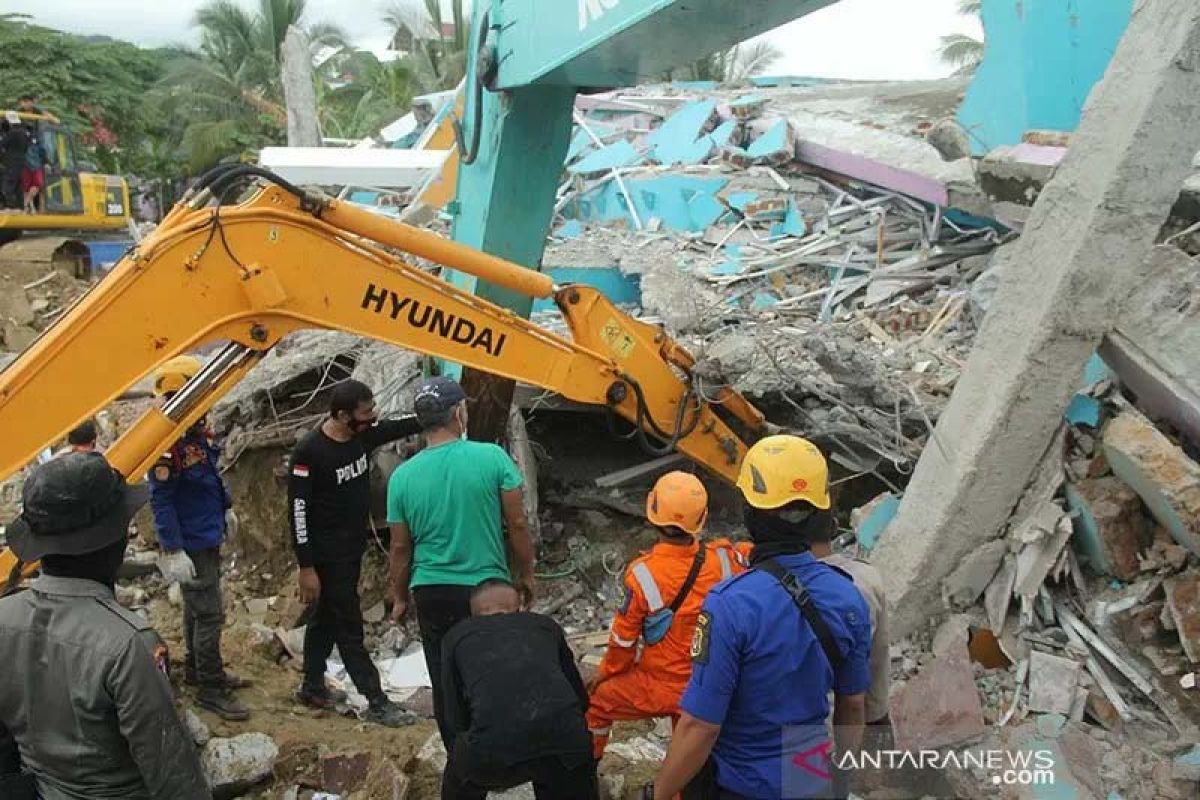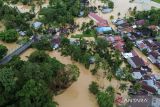Jakarta (ANTARA) - As a country located in the Pacific Ring of Fire, Indonesia is prone to natural disasters such as volcano eruption, earthquake, and tsunami, and hence its residents must be prepared for that.
Moreover, the world’s largest archipelagic country is strategically located between the Indian Ocean and the Pacific Ocean, that could induce extreme wet (La Nina) or dry seasons (El Nino) weather and ocean-related phenomena that could trigger flooding, drought and forest fires.
One of the worst disasters hitting Indonesia in modern history was the deadly tsunami which devastated Aceh Province and Nias Island (North Sumatra Province) on December 26, 2004, which killed around 200,000 people and rendered about one million others homeless. The tsunami was triggered by a powerful 8.9-magnitude earthquake.
In addition, since March 2020, Indonesia has been affected by the COVID-19 pandemic that has infected a total of 1,134,854 people and claimed 31,202 lives as of February 6, 2021. World-widely, nearly 106 million people have been infected by, and over 2.3 million others succumbed to the pandemic, which had never been predicted.
While entering 2021, Indonesia has to face other natural disasters besides the COVID-19 pandemic.
The country had been stricken by a total of 197 natural disasters during the January 1-23 period, according to data of the National Disaster Mitigation Agency (BNPB).
Most of those disasters were hydrometeorological disasters comprising 134 floods, 31 landslides, and 24 whirlwinds, that had claimed 184 lives, injured, 2,700 people, rendered nine people missing, and affected or displaced 1.9 million others.
Compared to January 2020, during the same period, BNPB recorded 297 disasters affecting across Indonesia, particularly massive flooding in Jakarta and surrounding areas, and claiming 91 lives.
The Meteorology, Climatology and Geophysics Agency (BMKG) has warned of likely hydrometeorological disasters such as floods, landslides and whirlwind, occurring simultaneously in several regions during the peak of the ongoing rainy season, which usually begins in September or October and ends in March or April.
"Since October 2020, the BMKG has issued early warnings of potential extreme weather-related conditions due to various phenomena that are feared to coincide with the rainy season," BMKG Head Dwikorita Karnawati said recently.
Among the 2021 January major disasters were landslides in Sumedang (West Java) on January 9, an earthquake in West Sulawesi on January 14, and massive flooding in South Kalimantan starting January 12.
Heavy rainfall and unstable soil caused a series of landslides in Sumedang, claiming 19 people, rendering 11 others missing, injuring 18 others and displacing over 1000 local residents. Among the deceased were rescuers.
In West Sulawesi, a 6.2-magnitude earthquake rocked Mamuju and Majene Districts claiming at least 105 lives, displacing thousands of people, destroying homes, infrastructure, and public facilities.
In fact, the BMKG recorded a total of 646 earthquakes of varying magnitudes and depths had hit Indonesia last month.
"The figure rose as compared to 518 earthquakes during the same period in 2020," Coordinator of the BMKG Earthquake and Tsunami Mitigation Section Daryono stated in early February 2021.
January 2021 was recorded as an "abnormal month" for earthquakes in the archipelago wherein the frequency of occurrence of tectonic earthquakes, whose tremors could be felt by residents, was above "normality".
The number of earthquakes in January 2020 is higher than the average of 555 earthquakes for January, he remarked. At least 85 of the 646 earthquakes could be felt in January 2021 as compared to 54 in January 2020.
Almost daily, earthquakes had hit Indonesia last month. Just on January 14, 2021, the country had recorded eight earthquakes. Three of the 646 earthquakes in January 2021 are classified as disastrous.
Based on the seismicity map, the BMKG had identified earthquake-active zones in January 2021, including Aceh, Nias, Bengkulu, Lampung, Lombok, Sumbawa, Sumba, West Sulawesi, Central Sulawesi, Gorontalo, Maluku Sea, and Seram.
Earthquake activities in the active zone may continue until February 2021, but they can also end and move to other areas.
"With increasing earthquake activities in January 2021 and earthquake active zones, we call on the public to remain calm and not to panic. However, they should remain vigilant," he stated.
In South Kalimantan, massive floods triggered by incessant heavy rains, inundated 10 districts and cities, displaced thousands of people, paralyzed the local economic and daily activities in the province.
President Joko Widodo (Jokowi), while visiting Banjar District, South Kalimantan, on January 18, said that the massive flooding was the first to have occurred in the province in the past 50 years.
The 10 flood-affected districts and cities are Tapin, Banjar, Banjar Baru, Tanah Laut City, Banjarmasin City, Hulu Sungai Tengah, Balangan, Tabalong, Hulu Sungai Selatan, and Batola.
The floods claimed 15 lives, swamped 24,379 houses, and displaced 39,549 people.
Floods had also reported in West Java, Central Java, East Java, West Sumatra, Aceh, Papua, East Kalimantan, North Sulawesi, and West Kalimantan
The Government claimed that the South Kalimantan flooding was due to extremely high precipitation during the current rainy season.
Minister of Environmental Affairs and Forestry, Siti Nurbaya, has outlined 11 recommendations to tackle flooding from upstream to downstream, including developing an agroforestry system, building flood control, land rehabilitation, community education, implementing land conservation buildings, and improving drainage and urban planning.
The Indonesian Forum for the Environment (Walhi), however, pointed out that the flooding was triggered deforestation as large parts of Kalimantan forests were converted into palm oil plantations and coal mining areas.
Walhi Executive Director Nur Hidayati said during a virtual launch of Environmental Review 2021 recently that he extreme weather is a concrete impact of climate change caused by the increase in greenhouse gas emissions due to use of fossil fuels and reduction in forest cover.
She urged the government to use the COVID-19-induced multi-dimensional crisis to make a change, particularly in the environmental sector, and treat it as a priority issue.
Coordinator of Walhi's political desk, Khalisa Khalid, also highlighted the significance of green politics and encouraged the endorsement of environmental issues as a priority, whereas the environment has not been seen as a priority issue so far
Green politics may offer a solution to the polarization of environmental issues, encourage the adoption of more environmentally friendly policies, and support public interest since the environment has a direct and indirect impact on human life, she noted.
Meanwhile, Luluk Nur Hamidah, a member of Commission IV of the House of Representatives (DPR), has believed that a series of recent disasters, such as flooding at a number of locations, were not only the result of weather anomalies, but also inappropriate and ineffective policies.
Hence, she urged that economic activities that exploit natural resources and make the environmental carrying capacity unsustainable must be stopped.
The lawmaker highlighted massive land clearing issues, such as land clearing for plantations in Kalimantan, which has increased from 15 percent to 72 percent in the last five years.
"In the last two years, land clearing for mining has increased by 13 percent. In addition, many protected forest areas have turned into plantations," she noted.
Regrettably, around 18,350 hectares of farming land in 11 districts has been threatened with crop failure due to flooding, she said and called on the government to implement right actions and policies without delay, such as implementing a land moratorium.
In the meantime, at two volcanoes – Mount Merapi and the 3,676-meter Mount Semeru in East Java have been erupting for several times since January this year, displacing hundreds of people and affecting several villages with volcanic ash rains.
The 2,968-meter Mount Merapi located between Central Java and Yogyakarta, is the most active among the around 130 active volcanoes in the country.



